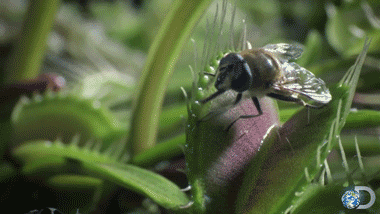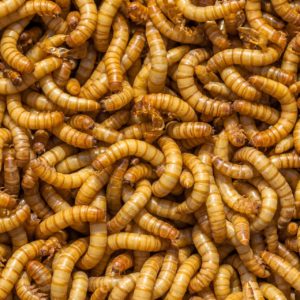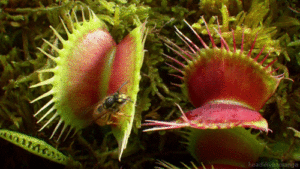Buy Carnivorous Plants Online!
Buy carnivorous plants from the most reputable and trusted carnivorous plant nursery, California Carnivores. We have partnered up and are giving all my viewers an exclusive 10% discount on your entire carnivorous plant order! Just enter CPHUB at checkout! Get the coolest venus flytrap cultivars, sarracenia, nepenthes and much MUCH more! You can even buy your next bag of premium carnivorous plant soil from them! Order Plant Mail, Click Here!Thank you for stopping by! Today we are going to talk about what to feed a venus flytrap and how to feed a venus fly trap. Were going to first discuss what to feed a venus fly trap and I’m afraid it just might not be as exciting as your expecting.
Note: Please press “show” above on the table of contents to jump to a specific part of this article.
We will then move on to how to feed a venus fly trap. There are some different methods and you can choose which way suits you! There are a lot of common misconceptions about the diet of a venus fly trap but we will make sure and spell any of those today.

Before we go too much further I did want to let you know about my ultimate venus fly trap care guide. Learn everything you would ever need to know about caring for a venus fly trap!
Ultimate Venus Flytrap Care Guide
Lets get going!
The Boring Answer
I think it’s important to note that there are many things to think about that is probably more important than what to feed a venus flytrap. Caring for a strong healthy flytrap takes a lot more than simply planting and dropping insects into its trap.
These plants are so much fun to grow and raise but do need some pretty special treatment. The treatment isn’t that difficult its just way different than other plants. If you already have a plant and want to know what to feed it, I also suggest taking a look at some of the articles below first!
If you already know everything below and your ready to feed your plant, skip it and let’s get to talking about what to feed a venus fly trap!
How Does A Venus Flytrap Work?
Venus Flytrap Soil Mix And Potting (Maybe one of the most important things to note)
Picking A Pot or Planter For Venus Flytrap
Venus Flytrap Dormancy (Yes, they hibernate and yes you need to know about it!)
That should get your started. The more you learn about these incredible plants the better chance you will have to successfully grow venus flytraps!
The More Fun Quick Answer
I will expand on this below a lot but wanted to provide you with the quick answer to what to feed your venus flytrap. You want to feed a venus flytrap either live or dried mealworms, blood worms and crickets. Any insect it may eat in the wild will work great. If you can catch house flies and freeze them to slow them down, this will also work well. They also need to “eat” lots of sun!
What To Feed A Venus Flytrap
For the majority of owners the honest answer to this question is you probably don’t need to feed it anything. One of the most important things to “feed” your venus flytrap is lots of sun.

Venus Flytrap Catching a live fly!
Whether you grow outside or inside, exposing your plant to as much sun as possible is the best thing to feed it. Also, if you move it outdoors or next to a sunny window it’s probably feeding enough on its own.
Okay, I get it, that’s a totally boring answer! Don’t worry, if you want to, you can feed your venus flytrap. And there are things you can get to feed it that will help it grow strong if it’s not getting enough food naturally.
How Often To Feed A Venus Flytrap
Okay, you really want to feed this plant, I totally get it I feel the same way. It’s so satisfying to see your venus flytrap close its trap around it’s prey. And lets face it, this is the reason many of us own these amazing plants.
Lets talk real quick about how often to feed a venus fly trap. I know you want to know the what, but its so important to know the how often before the what. Over feeding the plant can kill it.
The general rule for how often to feed a venus flytrap is that you should feed each plant every other week. This means feed just 1 head from the entire plant every other week. This will be enough food to feed the entire plant. Do not feed every or multiple traps at a time this can be bad for the venus flytrap.
Rules To Follow
Now that you understand how often to feed a venus flytrap I think we should discuss some general rules regarding feeding your plant.

- Avoid giving your venus flytrap any fertilizer or anything else labeled as “plant food”. They need nutrient poor soil, fertilizer will burn the roots and kill the plant.
- Some people like to call venus flytraps meat eaters. I mean, we call them carnivorous plants, so they must eat like a lion, right? Wrong. No meat. If it can’t catch it naturally it shouldn’t be eating it. This means no chicken, beef or any other kinds of meat.
- Try your best not to trigger the traps unless you need to. The plant expels a lot of energy when it closes the trap and can cause its growth to slow down. When the trap closes the plant is expecting to turn it’s victim into food.
- Make sure what you feed your venus flytrap is only about a third the size of the trap. If the prey is too big and the trap can’t completely close it could sit for a long time and rot the food and the trap.
- This one is important and the reason I only like to feed venus flytraps live food. The hair that triggered the trap to close needs to be triggered again for digestion to start. If you feed your venus flytrap a dead insect make sure you use a tooth pick to reach in and trigger the hair a few times to stimulate and trigger the digestion.
Feed Venus Fly Trap Live Insects
I do prefer to feed venus flytraps live insects if I’m going to feed them. It makes for something really fun to do when you have friends over. Just remember the rules above. Don’t over feed them!
One quick tip for feeding your venus flytrap live insects. Put the insect into the freezer for a couple minutes before giving it to your flytrap. You want to make very sure that if you put the insect into the trap that the flytrap is able to trap it. If the cricket jumps away it’s a missed opportunity for your flytrp.
The freezer slows them down a bit and makes them easier for your flytrap to capture.
Would you believe you can get live bugs and dried insects on Amazon? It’s crazy, but also awesome! We will talk about dried bugs down below in a bit.
Mealworms – These are a great source of nutrition for your venus flytrap. You can get these from pet stores but I prefer to buy them right off Amazon, link below. It’s incredible that we live in a time where we can order some mealworms and they arrive in a few days! If the worm is too long, make sure to cut them in half. This is especially true if you have a young venus flytrap.
Click Here To Buy Live Mealworms On Amazon

Crickets – These little critters can also be a great live source of food for your venus fly trap. Again, believe it or not, you can buy these guys right on Amazon! They are available in 1 inch or half inch, I have linked to the half inch below as it’s likely your venus flytrap traps are not big enough to eat 1 inch crickets.
Click Here To See Live Crickets On Amazon

Feed A Venus Flytrap Dried Insects
If you need to feed your venus flytrap insects, dried insects is definitely an option. As a matter of fact its debatable that this option is better, especially for beginning growers.
Mealworms have been known to burrow out of a flytrap trap which is counter productive and crickets are just quick sometimes. If you have no experience feeding venus flytraps live insects you may want to consider dried.
Just remember that if you decide to go this route you do need to trigger the hairs after the trap closes with a tooth pick or buy squeezing the sides of the trap gently.
You can also get all your dried insects straight off Amazon, check the links below to see price, user reviews and other important information.
Now that you have learned what to feed a venus flytrap lets talk about how to feed a venus fly trap.
How To Feed A Venus Fly Trap
Some of the stuff I’m about to cover is things I covered a bit above. I wanted to dig into it a little more. Also, if you jumped ahead to this part of the article, you may have missed some important things about feeding a venus flytrap.
What It Needs Most
What your venus flytrap needs the most in terms of food is as much sun as possible. I know this isn’t the typical answer when you think of the mighty carnivorous venus flytrap. Most people think of flies, and why wouldn’t they, it’s called a flytrap. The truth is they need a lot of sun. As much as 12-15 hours a day. If they aren’t getting enough sun they may never grow to their best potential.

It’s important to make sure that if you grow your venus flytrap outside that it’s in a spot that gets as much direct sun as possible. If you grow it on the inside make sure you move it t a window or outside when the sun is out. This will help your venus flytrap grow healthy and stay strong!
Feeding A Venus Flytrap Live Insects
Okay, I’ll step off my soapbox about sun and get to what you’re really here for. Lets talk about how to feed a venus flytrap live bugs. This is a risky endeavor, as your venus flytrap needs to make sure that if the trap shuts the bug gets caught.
Feeding your venus flytrap live bugs brings up a few issues. If the bug is able to escape before the trap closes the plant has wasted a lot of energy it needs by triggering the trap to close. The other risk is that even if your trap closes around the insect they are often times able to escape it’s clutches. This essentially ceates the same energy waste as missing the insect entirely.
I’m going to talk about some tricks to ensure your venus flytrap is able to successfully capture and digest a live insect.
One of the best tricks is to put the insect in the freezer for a few minutes before feeding your venus flytrap. This will make the insect stop moving. Once the insect starts to warm up after it’s been trapped the insect will trigger the hairs and begin digestion. Make sure not to leave the insect in the freezer too long or it will die. If it dies and you feed it to your trap you will need to manually trigger the hairs for digestion. We will talk more about this soon in the “feeding your venus flytrap dried insects”
You can also uses tweezers to get a good grip on the insect. Allow the plant to close around your tweezers and let go and slide the tweezers out. This is still a little risky but significantly reduces the risk of the flytrap escaping.
This seems a little less humane and it’s not something I do, but others have. You can always pull the legs from the insect. If your feeding your venus flytrap crickets you can pull the legs off so it will squirm a bit but can’t jump out. Again, it’s not my cup of tea as I think there are better ways. But when it’s all said and done you are feeding this insect to a plant, so whatever you decide!
Feeding A Venus Flytrap Dried Insects
There is a little more labor involved with this process. The insect is dead and will not stimulate the inside of the venus flytrap. Imagine how these plants have evolved. They know when they catch an insect that the little guy is going to wiggle and move around. If there is not wiggle or move around, they will actually open up and not digest the insect.
The way it works is… If you drop a dead bug in your flytrap and they don’t stimulate the hairs inside the trap it won’t trigger venus flytrap digestion. The enzymes wont’ release and the plant will open. This is a design to help them avoid wasting even more energy and resources on something that inadvertently triggered a trap to close. They really are pretty smart, aren’t they?
If you would like to learn more about how all this and much more works with a venus flytrap, click below to another article I wrote!
How Does A Venus Flytrap Work?

The trick to getting them to digest the dried insect is you have to stimulate the trigger hair after the trap has closed. The trap will actually close tighter once the hairs have been triggered to help avoid an escape. There area couple different things you can do to trigger the stimulation.
Gently (very gently) squeeze together to trap to help it close a little more and to stimulate the hairs on the inside. You can give it a few squeezes (as long as your gentle) to make sure it takes. This process helps the flytrap close down tighter and trigger the enzymes to come out and start digesting it’s prey.
The other thing you can do is to stick a toothpick or a bent paperclip, anything that has that basic shape, into the trap and stimulate the hairs manually. The trap should proceed to close a little tighter and start digesting the insect.
If the trap opens up a few hours later you know that this was not successful. If the trap stays closed for 5-12 days you know it’s working on digestion and providing energy the plant will eat up!
If you want more info on what a venus flytrap eats, I cover all that above!
Feeding A Venus Flytrap Video
Check out this cool video of people feeding venus flytraps. Not so much instructional, just really cool!
Conclusion
We have completely covered what a venus flytrap eats and how a venus flytrap eats. Venus flytraps aren’t that hard to take care of, they are just so different than regular plants. We really have to ignore most of what we have been taught about gardening and planting.
I’m so excited you are here to learn about venus flytraps and hope that this info has helped you in some way with your precious plant. Keep them in the sun, make sure they have appropriate amounts of water and throw them a bug from time to time. That’s the super simple formula for having a healthy and happy venus flytrap.
Thank you again for stopping by, here’s to everyone having healthy flytraps!


